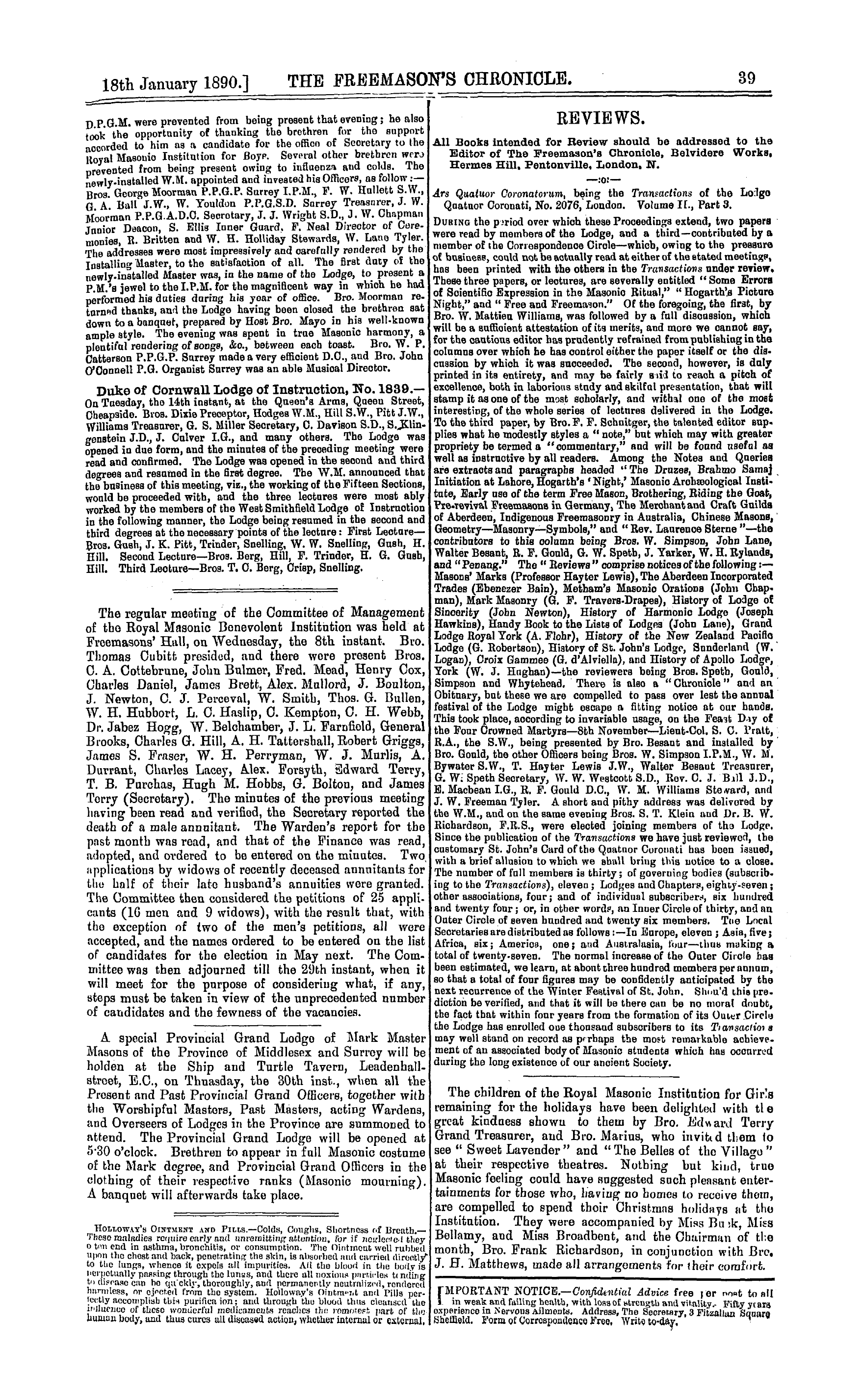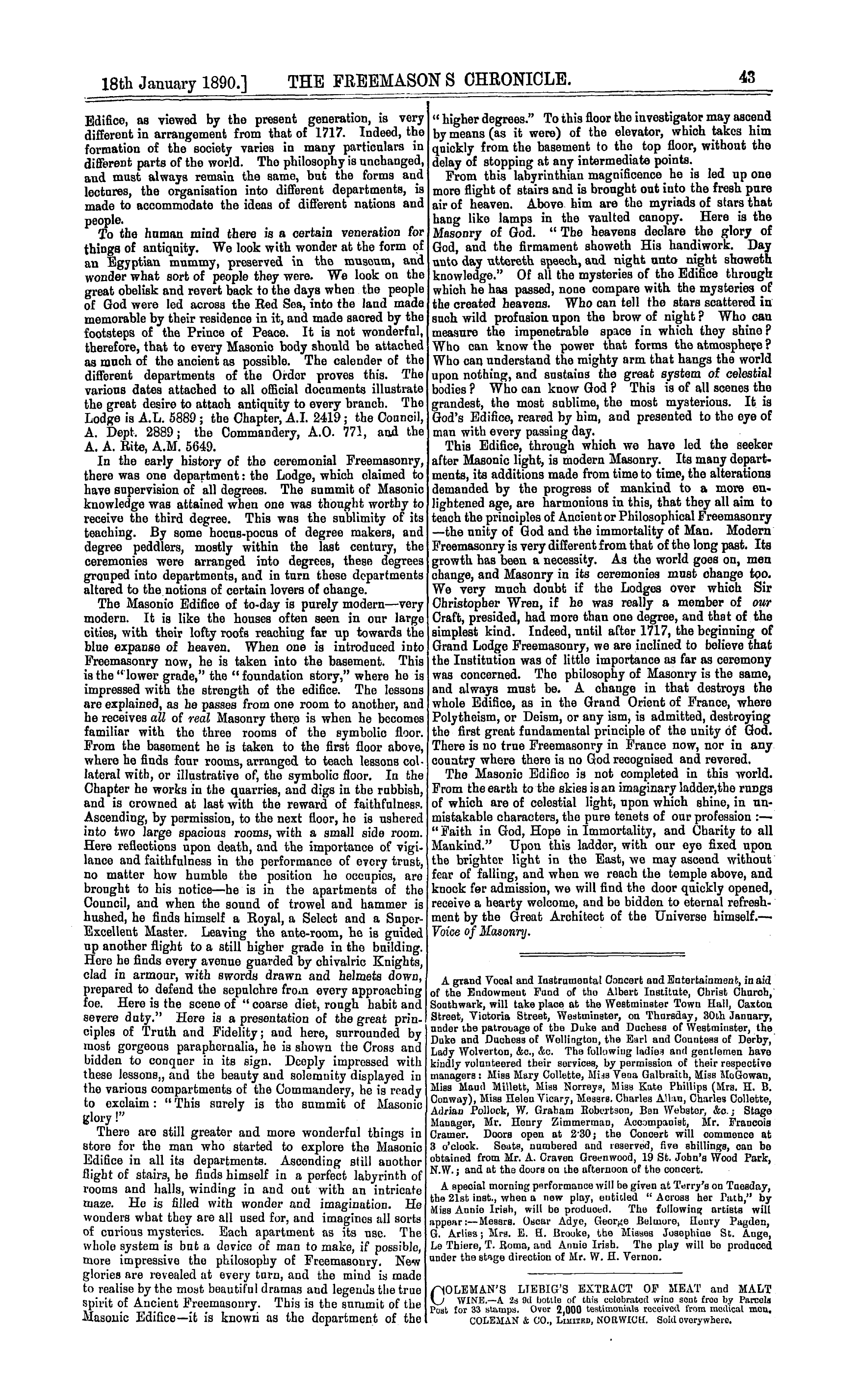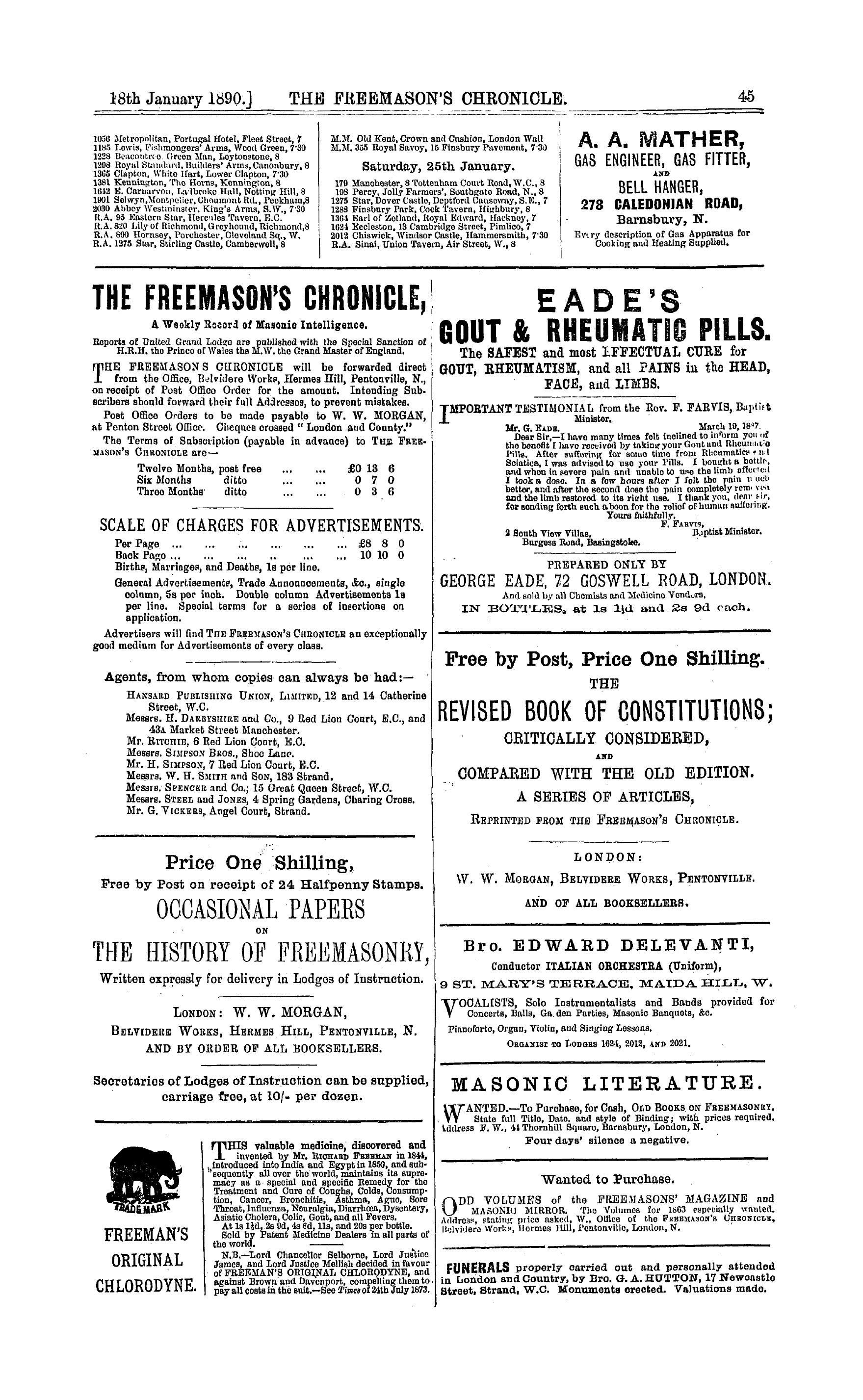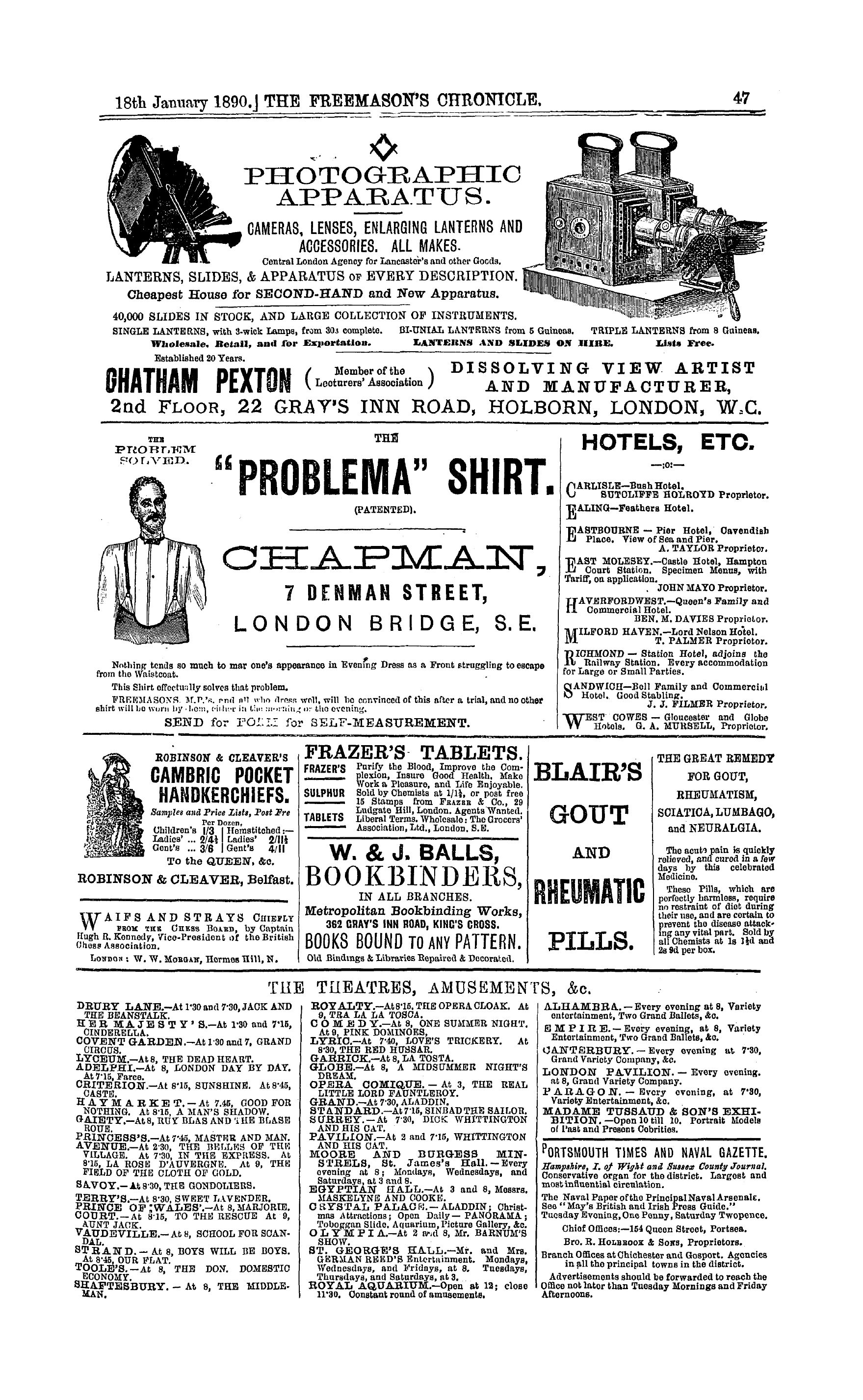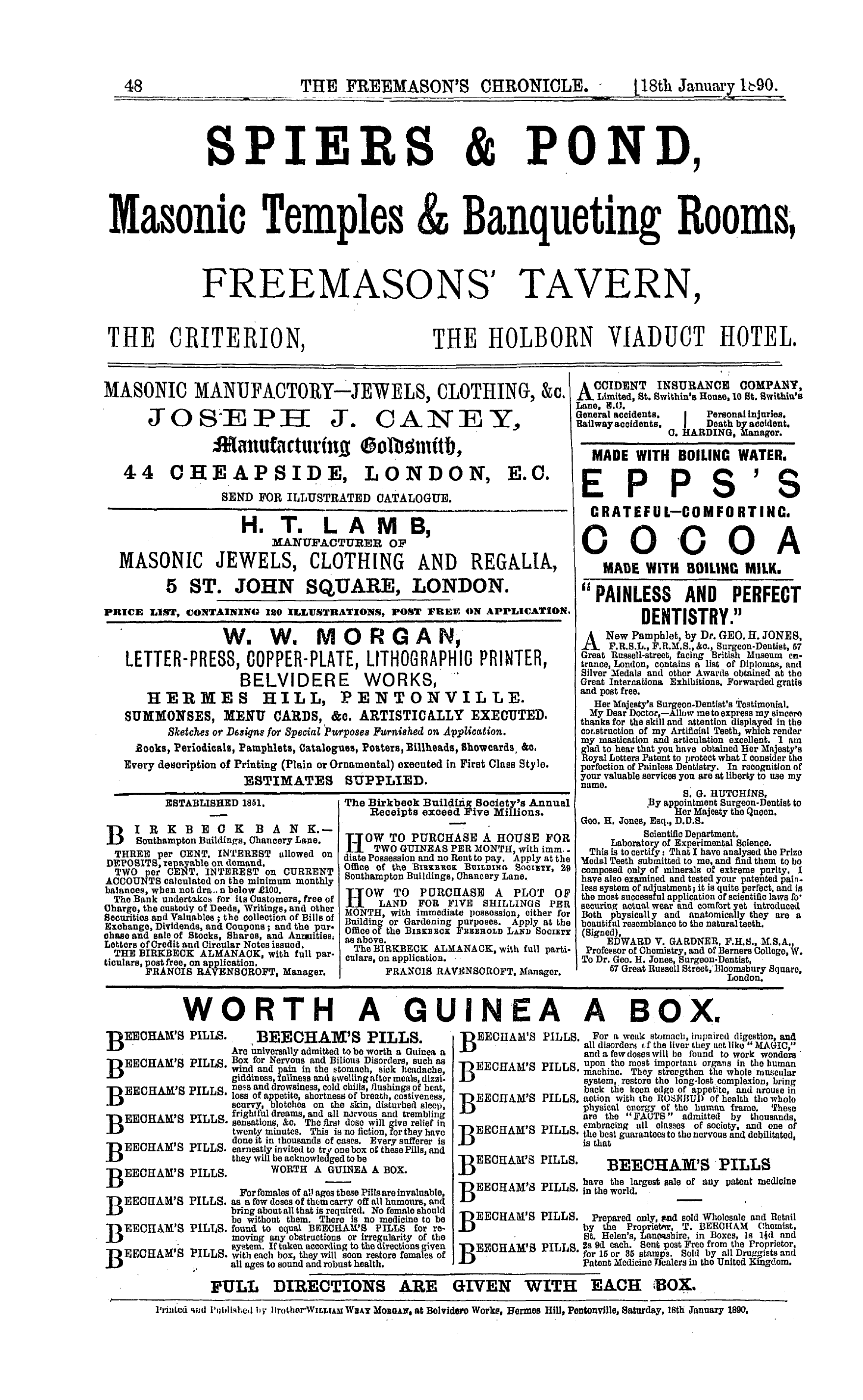-
Articles/Ads
Article AN INACCURATE HISTORIAN. ← Page 3 of 3 Article THE MASONIC EDIFICE. Page 1 of 2 →
Note: This text has been automatically extracted via Optical Character Recognition (OCR) software.
An Inaccurate Historian.
in regard to the Kingps condition are directly contradicted by Mr . Yarker . In May 1786 , Frederick was as competent to transact any business as he ever was in his life ; and this all the historians attest , Lord Dover , Carlisle and others—all except Yarker . These Grand Constitutions nviy be apocryphal ; but the only
reason ever given for holding them so is false ; and Cerneauism cannot impeach the genuineness of the Latin version , not merely because it first produced them in this country , in 1832 , but because it must , to do so , stigmatise its own representatives , Lafayette and St . Laurent , and the six of the fther Councils with which its Hioks-Sfc . Laurent Counail made a Tr-aty afc Paris in 1834 , as
wilful and deliberate liars , and accomplices after the fact , in forgery . The truth probably is , that tbe Comte To Grasse returned to France , to look after his forfeited property there , when , by decree of tho Consuls , those emigre ' s who had not borne arms against France , were allowed to return ; and that on his return to Charleston he brought with him tho unauthenticated French version of the
Grand Constitutions . Thafc this version was forged afc Charleston , there is not the least reason to believe . Nor is there any reason to believe that Cernrauism forged at New York the Constitutions of 1786 . It is not permissible to impute fraud and baseness , without proof . I think that the Comte St . Laurent brought them to the United Stntes in 1832 . He certified
to their genuineness in 1834 , with Lafayette , aud some one produced what purported to be the authentic original , and convinced seven other intelligent gentlemen , to whom it was submitted for inspection , of its authenticity . It is not permissible to doubt that . It is proof produced by Cerneau itself . Mr . Yarker , receiving his twenty-five Degrees as he states , must
acknowledge the authenticity and genuineness of the Constitutions and Regulations , which bear date the 22 nd of December 1762 . Bnt tbere is not the slightest real proof that they were made when or as they purport to have been . They were never authenticated by any signatures . They were firsfc published in 1832 , at Paris , by the Supreme Council of France . Stephen Morin left France for the West Indies , not long after August 1761 , and ifc is not known thafc these
Constitutions were ever sent to him from France . In fact , it is nofc known that he ever had them . Ifc does appear thafc he had a copy of fche Secret Constitutions of the 33 rd Degreo , purporting to have been made on tbe very day of the date of his Patent , 27 th August 1761 . These latter , ifc is certain , aro spurious , and it is my belief thafc both they and the Constitutions and Regulations of 1762 were made in the West Indies . But I should be utterly lost to all considerations of common decency , to charge Stephen Morin with having / orged them .
6 . " Soon after this Joseph Cerneau landed in New York from the West Indies , a member of the Grand Orient of France , and eetiblished for the first time a body of the Rite in the North . To say the least , his title and antecedents were superior to Morin ' s . " One would like to see the proof that Cerneau was " a member of the Grand Orient of Franco . " He was a member , in the West Indies ,
of a Lodge nnder the Grand Lodge of Pennsylvania ; in 1801 an 18 th of the Rito of Perfection under authority derived from Stephen Morin , and in July 1806 , at Baracoo , in Cuba , was made 25 th , and Deputy Inspector for tho northern parfc of Cuba , by Antione Matbieu Dupotet , himself a Deputy Inspector 25 th , under authority derived from Morin . That is Joseph Cerneau ' s Masonic history . In Cuba
he had been Master of a Lodge and member of a Provincial Grand Lodge , both created by tho Graud Lodgo of Pennsylvania . Ho never belonged to a Body under the Grand Orient of France , or was of its obedience afc all ; and all the authority he had was derived from Morin . 7 . " The forger Dalcho , " seeing the success of Cerneau in New York , sent there a crazy Jew of the name of De la Motta to try to
'finger some of the monisb . ' The forged charter of Frederick the Great clearly turned his brain , and he had the crazy audacity to issue an edict expelling De Witt Clinton , Cerneau , and all their abettors , from every Masonic Body throughout the world . " " The forger Dalcho" did nofc send De la Motta to New York . Emnnuel de la Motta was an eminent physician , a man highly
respected in the city of his residence—Charleston—where gentlemen lived ; and he was in New York , upon business of his own , when he found Cerneau figuring tbere , giving the Templar Degree and peddling one of his o « vn manufacture , "Aaron ' s Band . " We have always had Hebrews in this country quite as respectable as Mr . Yarker , and quite as much above " fingering some of the
monish . There have beeu somo such in England , not quite worthy , perhaps , of Mr . Yarker's consideration , but who did , nevertheless , associate with gentlemen—for example , D'Israeli and Sir Mo ^ es Montefiore . " THE FOECER DALCHO . " It may be in keeping with the character of au Euglich gentleman to apply this phrase , gratuitously and
wantonly , to snoh a man as Frederick Dalcho , Scholar , Soldier , Physician and Divine , who ft least did not need to ascend to be upon Mr . Yarker ' s level . Finally , this gentleman says , of the members of tbe Supreme Council at Charleston , from its origin until now : " From this time forth the whole of their history is one of forgery , lying , swindling * and
bliifkguardism . " Vei ily , this is a mosfc e vil , courteous and sweetly-mannered person , who proves in his own personal nature , as this production reveals it , tho infinite difference between au English gentlemnn and—himself . Thero is no other answer to be made in words to this comprehensive libel . The importance if its author , even in the English Masonic
world , is not large enough to give weight to h \ s opinions of men . The Dead , agiiinso whom ho brings this railing accusation , need not 7 ti . s endoisi ment , and would not in their lifetime have felt honoured by it ; and the living aie flattered and honoured by his ill opinion . Cerneanism is tn be either conprat-ulated or commiserated npon its acquisition of a new cbampi n , as men may look at it in oue way or tho other . AiiiiKiti PIKE , 33 " .
The Masonic Edifice.
THE MASONIC EDIFICE .
THERE are two views to be taken of Freemasonry : oue tbe philosophical , which is the true and the ancient , and the other the ceremonial , which is of comparatively modern invention . In all ages of the world there have been " mysteries" that have been regarded with profonnd respect , and in many instances with awe . They tanght a
secret doctrine very different from that imparted to the multitudes and in public . Warburton defines what these mysteries were : " Each of the pagan gods had , beside the public and open , a secret worship paid unto him to which none were admitted but those who had been selected by
preparatory ceremonies , called initiation . " This was true in Persia , where the mysteries were dedicated to Mithras , or the sun in Egypt , to Isis and Osiris ; in Greece , to Demeter ; in Syria , to Dionysus . The great design of the mysteries was to teach the existence of one God , and that
the multitude of deities of the popular theology were but the attributes belonging to Him . The candidate was also taught that the soul emanating from that Spirit who was invisible and indivisible , could * ' never see corruption , " but after death would be raised to " eternal life . " The student
of the Egyptian mysteries , and the Persian , will be struck with the similarity they boar to tho teachings of Freemasonry . It is no doubt this that haa led so many writers and searchers after the origin of our Craft , to trace its history through all the ages of the pasfc , and try to connect
even the ceremonies of our day with those of -Meneptab . If we take the philosophical view of Freemasonry , this ia true . The " tenets of our profession " may be traced back almost to the beginning of time . These teach prominently two things : 1 . The existence of one true and living God ,
from whose plastic hand came all created nature , and by whose Almighty power the universe is sustained ; and , 2 . The immortality of Man , created in the likeness of God , whose duty it is to reverence and obey his Maker . Around
these two great doctrines cluster all the teachings of Freemasonry . These teachings aro divided into many groups of impressive lessons , pictured in allegory and symbol , to portray the varied duties the great family of mankind owe to God and to each other . The whole of created nature is
introduced to instruct tho mind . The sun , moon and stars are made to show the power and wisdom and glory of the Great Architect who framed them . The open grave , with its solemn surroundings , teaches the mortality of man and tho uncertainty and brevity of human life . The sprig of
acacia , ever living , reviving and taking root at tho slightest touch of mother earth , is used to teach that there is an immortal part in man—aye , that man himself , tho real
man " will , never , never , never die . " Every ono of the numerous symbols of Freemasonry is intended to deeply impress upon the mind some truth known and taught long before the Institution itself had an existence . It will suit
our purpose to go no further back than the age when the world began anew with Noah , although the same unity of God , and immortality of the soul , were tanght long before that period , to find tho philosophy of Freemasonry . These doctrines wero transmitted by Noah , through his
immediate descendants , and in turn by them to their children , until tbey have reached ns in this remote age , unimpaired and unchanged . It is this part of the Institntion that has stood the test of ages , against whose existence no warfare has ever been successful . For a time the true
light may have been hidden by heathen mythology , by ignorance and superstition , but ifc still burned , and within the " mysteries " of the past was preserved , and comes
forth as bright as ever . Monuments and the greatest of earthly buildings have crumbled to dust , but "Freemasonry still survives " and remains stronger and purer from the trial .
The ceremonies of Freemasonry aro modern . Societies with a similar organisation existed before , bnfc Freemasonry , as wo understand it , and as practiced to-day , had its rise early in the eighteenth century . Prior to the reign of Queen Anne of England , it was confined to Operative
Masons , During her reign a decree was issued , "that the privileges of Masonry should be no longer restricted to Operative Masons , but extend to men of varions professions , provided they weie regularly approved and initiated into the Order . " The ceremonials of Freemasonry aro not tbe same as thoso prapticed in Queen Anne ' s time . In essentials ,
perhaps , a few nearly resemble them ; but the Masonic
Note: This text has been automatically extracted via Optical Character Recognition (OCR) software.
An Inaccurate Historian.
in regard to the Kingps condition are directly contradicted by Mr . Yarker . In May 1786 , Frederick was as competent to transact any business as he ever was in his life ; and this all the historians attest , Lord Dover , Carlisle and others—all except Yarker . These Grand Constitutions nviy be apocryphal ; but the only
reason ever given for holding them so is false ; and Cerneauism cannot impeach the genuineness of the Latin version , not merely because it first produced them in this country , in 1832 , but because it must , to do so , stigmatise its own representatives , Lafayette and St . Laurent , and the six of the fther Councils with which its Hioks-Sfc . Laurent Counail made a Tr-aty afc Paris in 1834 , as
wilful and deliberate liars , and accomplices after the fact , in forgery . The truth probably is , that tbe Comte To Grasse returned to France , to look after his forfeited property there , when , by decree of tho Consuls , those emigre ' s who had not borne arms against France , were allowed to return ; and that on his return to Charleston he brought with him tho unauthenticated French version of the
Grand Constitutions . Thafc this version was forged afc Charleston , there is not the least reason to believe . Nor is there any reason to believe that Cernrauism forged at New York the Constitutions of 1786 . It is not permissible to impute fraud and baseness , without proof . I think that the Comte St . Laurent brought them to the United Stntes in 1832 . He certified
to their genuineness in 1834 , with Lafayette , aud some one produced what purported to be the authentic original , and convinced seven other intelligent gentlemen , to whom it was submitted for inspection , of its authenticity . It is not permissible to doubt that . It is proof produced by Cerneau itself . Mr . Yarker , receiving his twenty-five Degrees as he states , must
acknowledge the authenticity and genuineness of the Constitutions and Regulations , which bear date the 22 nd of December 1762 . Bnt tbere is not the slightest real proof that they were made when or as they purport to have been . They were never authenticated by any signatures . They were firsfc published in 1832 , at Paris , by the Supreme Council of France . Stephen Morin left France for the West Indies , not long after August 1761 , and ifc is not known thafc these
Constitutions were ever sent to him from France . In fact , it is nofc known that he ever had them . Ifc does appear thafc he had a copy of fche Secret Constitutions of the 33 rd Degreo , purporting to have been made on tbe very day of the date of his Patent , 27 th August 1761 . These latter , ifc is certain , aro spurious , and it is my belief thafc both they and the Constitutions and Regulations of 1762 were made in the West Indies . But I should be utterly lost to all considerations of common decency , to charge Stephen Morin with having / orged them .
6 . " Soon after this Joseph Cerneau landed in New York from the West Indies , a member of the Grand Orient of France , and eetiblished for the first time a body of the Rite in the North . To say the least , his title and antecedents were superior to Morin ' s . " One would like to see the proof that Cerneau was " a member of the Grand Orient of Franco . " He was a member , in the West Indies ,
of a Lodge nnder the Grand Lodge of Pennsylvania ; in 1801 an 18 th of the Rito of Perfection under authority derived from Stephen Morin , and in July 1806 , at Baracoo , in Cuba , was made 25 th , and Deputy Inspector for tho northern parfc of Cuba , by Antione Matbieu Dupotet , himself a Deputy Inspector 25 th , under authority derived from Morin . That is Joseph Cerneau ' s Masonic history . In Cuba
he had been Master of a Lodge and member of a Provincial Grand Lodge , both created by tho Graud Lodgo of Pennsylvania . Ho never belonged to a Body under the Grand Orient of France , or was of its obedience afc all ; and all the authority he had was derived from Morin . 7 . " The forger Dalcho , " seeing the success of Cerneau in New York , sent there a crazy Jew of the name of De la Motta to try to
'finger some of the monisb . ' The forged charter of Frederick the Great clearly turned his brain , and he had the crazy audacity to issue an edict expelling De Witt Clinton , Cerneau , and all their abettors , from every Masonic Body throughout the world . " " The forger Dalcho" did nofc send De la Motta to New York . Emnnuel de la Motta was an eminent physician , a man highly
respected in the city of his residence—Charleston—where gentlemen lived ; and he was in New York , upon business of his own , when he found Cerneau figuring tbere , giving the Templar Degree and peddling one of his o « vn manufacture , "Aaron ' s Band . " We have always had Hebrews in this country quite as respectable as Mr . Yarker , and quite as much above " fingering some of the
monish . There have beeu somo such in England , not quite worthy , perhaps , of Mr . Yarker's consideration , but who did , nevertheless , associate with gentlemen—for example , D'Israeli and Sir Mo ^ es Montefiore . " THE FOECER DALCHO . " It may be in keeping with the character of au Euglich gentleman to apply this phrase , gratuitously and
wantonly , to snoh a man as Frederick Dalcho , Scholar , Soldier , Physician and Divine , who ft least did not need to ascend to be upon Mr . Yarker ' s level . Finally , this gentleman says , of the members of tbe Supreme Council at Charleston , from its origin until now : " From this time forth the whole of their history is one of forgery , lying , swindling * and
bliifkguardism . " Vei ily , this is a mosfc e vil , courteous and sweetly-mannered person , who proves in his own personal nature , as this production reveals it , tho infinite difference between au English gentlemnn and—himself . Thero is no other answer to be made in words to this comprehensive libel . The importance if its author , even in the English Masonic
world , is not large enough to give weight to h \ s opinions of men . The Dead , agiiinso whom ho brings this railing accusation , need not 7 ti . s endoisi ment , and would not in their lifetime have felt honoured by it ; and the living aie flattered and honoured by his ill opinion . Cerneanism is tn be either conprat-ulated or commiserated npon its acquisition of a new cbampi n , as men may look at it in oue way or tho other . AiiiiKiti PIKE , 33 " .
The Masonic Edifice.
THE MASONIC EDIFICE .
THERE are two views to be taken of Freemasonry : oue tbe philosophical , which is the true and the ancient , and the other the ceremonial , which is of comparatively modern invention . In all ages of the world there have been " mysteries" that have been regarded with profonnd respect , and in many instances with awe . They tanght a
secret doctrine very different from that imparted to the multitudes and in public . Warburton defines what these mysteries were : " Each of the pagan gods had , beside the public and open , a secret worship paid unto him to which none were admitted but those who had been selected by
preparatory ceremonies , called initiation . " This was true in Persia , where the mysteries were dedicated to Mithras , or the sun in Egypt , to Isis and Osiris ; in Greece , to Demeter ; in Syria , to Dionysus . The great design of the mysteries was to teach the existence of one God , and that
the multitude of deities of the popular theology were but the attributes belonging to Him . The candidate was also taught that the soul emanating from that Spirit who was invisible and indivisible , could * ' never see corruption , " but after death would be raised to " eternal life . " The student
of the Egyptian mysteries , and the Persian , will be struck with the similarity they boar to tho teachings of Freemasonry . It is no doubt this that haa led so many writers and searchers after the origin of our Craft , to trace its history through all the ages of the pasfc , and try to connect
even the ceremonies of our day with those of -Meneptab . If we take the philosophical view of Freemasonry , this ia true . The " tenets of our profession " may be traced back almost to the beginning of time . These teach prominently two things : 1 . The existence of one true and living God ,
from whose plastic hand came all created nature , and by whose Almighty power the universe is sustained ; and , 2 . The immortality of Man , created in the likeness of God , whose duty it is to reverence and obey his Maker . Around
these two great doctrines cluster all the teachings of Freemasonry . These teachings aro divided into many groups of impressive lessons , pictured in allegory and symbol , to portray the varied duties the great family of mankind owe to God and to each other . The whole of created nature is
introduced to instruct tho mind . The sun , moon and stars are made to show the power and wisdom and glory of the Great Architect who framed them . The open grave , with its solemn surroundings , teaches the mortality of man and tho uncertainty and brevity of human life . The sprig of
acacia , ever living , reviving and taking root at tho slightest touch of mother earth , is used to teach that there is an immortal part in man—aye , that man himself , tho real
man " will , never , never , never die . " Every ono of the numerous symbols of Freemasonry is intended to deeply impress upon the mind some truth known and taught long before the Institution itself had an existence . It will suit
our purpose to go no further back than the age when the world began anew with Noah , although the same unity of God , and immortality of the soul , were tanght long before that period , to find tho philosophy of Freemasonry . These doctrines wero transmitted by Noah , through his
immediate descendants , and in turn by them to their children , until tbey have reached ns in this remote age , unimpaired and unchanged . It is this part of the Institntion that has stood the test of ages , against whose existence no warfare has ever been successful . For a time the true
light may have been hidden by heathen mythology , by ignorance and superstition , but ifc still burned , and within the " mysteries " of the past was preserved , and comes
forth as bright as ever . Monuments and the greatest of earthly buildings have crumbled to dust , but "Freemasonry still survives " and remains stronger and purer from the trial .
The ceremonies of Freemasonry aro modern . Societies with a similar organisation existed before , bnfc Freemasonry , as wo understand it , and as practiced to-day , had its rise early in the eighteenth century . Prior to the reign of Queen Anne of England , it was confined to Operative
Masons , During her reign a decree was issued , "that the privileges of Masonry should be no longer restricted to Operative Masons , but extend to men of varions professions , provided they weie regularly approved and initiated into the Order . " The ceremonials of Freemasonry aro not tbe same as thoso prapticed in Queen Anne ' s time . In essentials ,
perhaps , a few nearly resemble them ; but the Masonic






